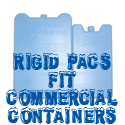How can I ensure that my insulated package has enough cooling and insulation? The design of an insulated shipping package needs to strike a balance between optimum thermal protection and cost. If the package fails to maintain foods or vaccines temperatures in the appropriate range, there can be catastrophic consequences for the consumer (e.g. food poisoning or disease exposure). Therefore, shippers need to focus on designing a box that is able to withstand realistic transport conditions while optimizing costs. This sounds easy, but the reality is that optimizing even a simple insulated box can be a complex problem. Variables include selection of insulation materials and coolant, box dimensions and insulation thicknesses, physical arrangement (including the insertion of a divider between coolant and product) and the initial temperatures of product and coolant. The final goal of the designer is to ensure that product temperature is maintained throughout the voyage, while the costs of the box as a function of both the materials used in construction and the cost of shipment per volume or weight, is minimised. Table 2 shows the most significant variables affecting the thermal performance of insulated packages.
|
Component
|
Variable
|
| Cardboard Box | Material
Thickness Thermal conductivity Emissivity Surface area |
| Insulation layer | Material
Thickness Thermal conductivity |
| Cooling agent | Material
Thickness Bulk density (when ready to be used) Specific heat capacity Melting point Thermal conductivity Latent heat Initial temperature |
| Bubble wrap | Thickness
Thermal conductivity |
| Product | Bulk density (mass per unit volume of loose material)
Shape Initial temperature Thermal properties |
| Transport conditions | Temperature in the cargo space throughout the voyage
External (ambient) temperatures throughout the handling of the package Transport schedules, including loading and unloading |
A typical method to assess whether an insulated container is ‘fit for purpose’ is to develop a prototype design and subject it to physical testing under standard temperature regimes in laboratory conditions. These regimes are normally cyclic temperature profiles, which simulate the actual environment the product will face during transit. The cyclic temperature profile setting depends on the departure location and destination, mode of transportation and the season in which the product is shipped.
The second method to assess the suitability of insulated containers for specific cold chain uses is the use of mathematical models or simplified calculations that determine the required insulation efficiency and the amount of coolant needed. The accuracy of these calculations varies and, although useful, they are not a full replacement for the ultimate testing of the package on realistic transport scenarios. However, they can decrease substantially the traditional trial-and-error approach, thus reducing testing costs, time and effort.
Laboratory performance testing is performed following the ASTM D3103-07 standard, the Standard Test Method for Thermal Insulation Performance of Packages, ISTA Guide 5B: Focused Simulation Guide for Thermal Performance Testing of Temperature Controlled Transport Packaging, and others. However, nothing beats field performance validation. If you require design, testing and validation services, we can put you in contact with expert consultants in the field.









How Gel Ice Works